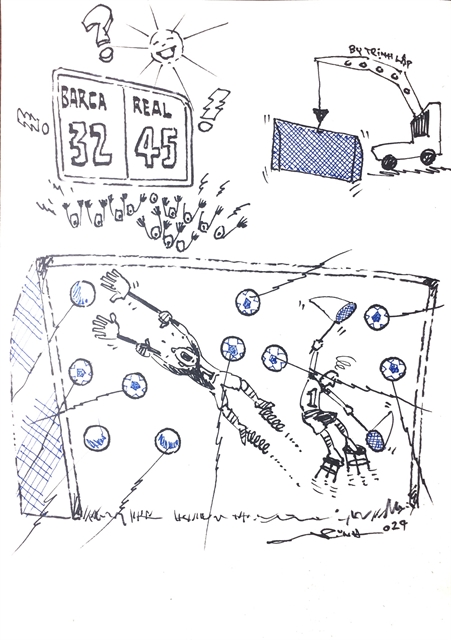 Talk Around Town
Talk Around Town


|
| Illustration by Trịnh Lập |
By Thanh Nga
Legendary Italian goalkeeper Gianluigi Buffon has suggested that the size of football goals should be increased. While this is Buffon's opinion, it is not without merit.
Buffon pointed out that the dimensions of football goals have remained unchanged since the late 19th century. However, the stature of goalkeepers and players has evolved significantly since then. As goalkeepers have become taller, shots on goal have become less effective, resulting in fewer goals and a decline in the attractiveness of the game.
The official dimensions of 11-a-side football goalposts have remained at 7.32m wide and 2.44m high since 1875, without any modifications.
Buffon argued that taller goalkeepers have a significant impact on scoring, particularly from long shots. He noted that three decades ago, out of 50 long-range attempts, around 10 would result in goals. Nowadays, even achieving success with two or three shots against towering 2m tall goalkeepers is considered a feat. Scoring against such goalkeepers has become exceedingly difficult.
As one of the greatest goalkeepers in football history, with over 1,000 matches to his name, Buffon's proposal to adjust goal sizes opens up a thought-provoking debate. Increasing the dimensions of the goal to align with the evolving physique of players could make matches more attractive and lead to more goals being scored.
The world of sports is dynamic and constantly evolving to captivate audiences and respond to market demands. Football, like other sports, has undergone numerous rule changes to increase excitement and pace. For example, restrictions on goalkeepers' hand usage were introduced to discourage excessive back-passing. Similarly, sports such as table tennis and volleyball have modified their regulations to enhance the game's difficulty and engage viewers. Adapting to the changing physical conditions of players is crucial to maintaining the sport's appeal and retaining its audience.
It is possible that the lack of appeal in modern football may eventually lead governing bodies like FIFA to consider rule amendments that accommodate the changing physical conditions of players.
Similarly, adjustments could be made in sports like volleyball by raising the nets and widening the field. However, concerns have been raised that Southeast Asian countries, including Việt Nam, already face disadvantages in terms of physical strength compared to European and American counterparts. Such changes may further widen the gap.
To address this, it becomes essential to improve the physical fitness of Vietnamese players. While winning the World Cup may remain a distant dream, football continues to be immensely popular here, making it a worthy investment for the state budget. However, with sports that have a larger audience, such as football and volleyball, the state should create more open mechanisms that encourage socialisation and maximise private resources.
The limited state budget can be allocated strategically to support key sports where Vietnamese athletes have a competitive advantage, even if they have a smaller viewership. Sports such as table tennis, shooting, chess, gymnastics, and martial arts offer opportunities for success. While Western countries may struggle to match Japan and China in table tennis, they have consistently excelled in athletics for decades.
The recent data from the conference on the future of elite sports development by 2030 sheds light on the financial landscape of the sports industry. Each year, a substantial sum of nearly VNĐ600 - VNĐ900 billion is allocated to various aspects, including facilities, training expenses, and athletes' salaries.
While football garners the largest share, it remains a mere fraction of the total costs required. Nonetheless, it is worth noting that the Việt Nam Football Federation stands out as the most socially engaged federation in the country, leading to significant improvements in the living and training conditions for football players.
However, the recent defeats of Vietnamese players against Indonesian counterparts, half of whom are naturalised players from Europe, along with scandals exposing financial constraints in sports including table tennis and gymnastics, highlight the urgent need for enhanced management and oversight by sports authorities.
So, in light of Buffon's thought-provoking proposal, it is crucial for Vietnamese sports to prioritise the enhancement of athletes' physical fitness and the implementation of dynamic mechanisms that foster socialisation and optimise resource utilisation.
By embracing these measures, Việt Nam has the remarkable opportunity to amplify its competitive edge in the world of sports and unlock a new realm of achievements on the international stage. VNS




